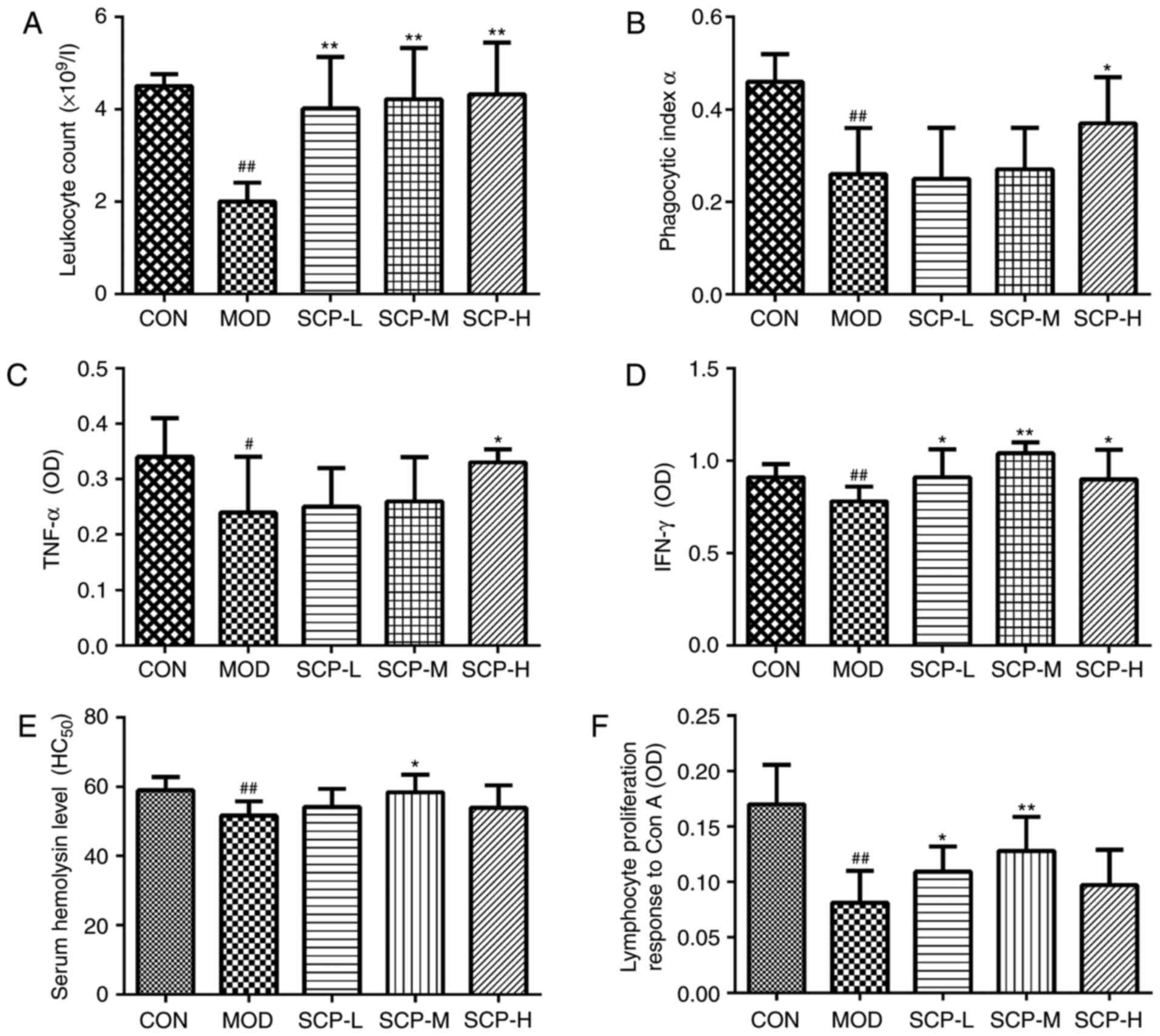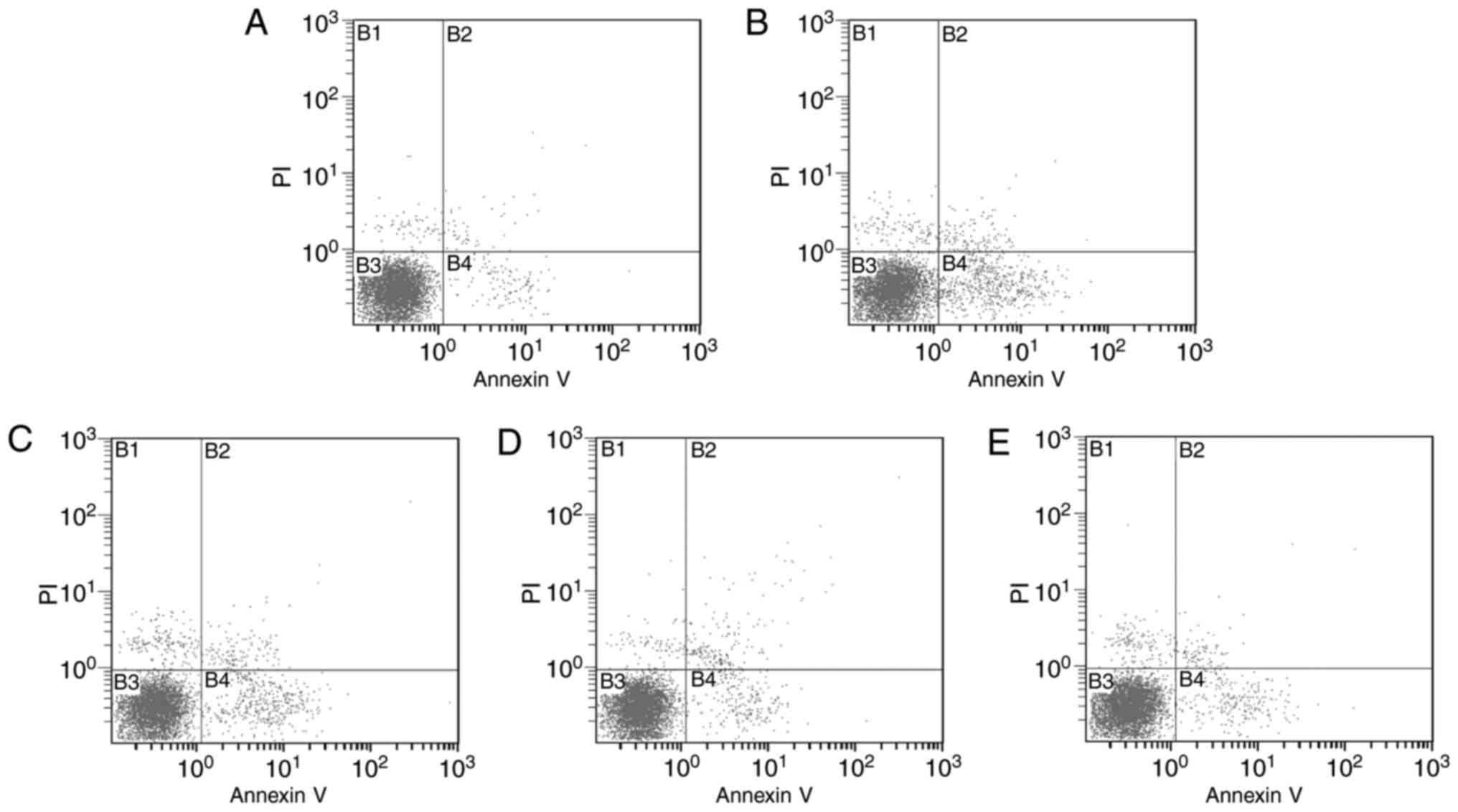|
1
|
Althouse R, Huff J, Tomatis L and Wilbourn
J: Chemicals and industrial processes associated with cancer in
humans. IARC Monographs Volumes 1 to 20. IARC Monogr Eval Carcinog
Risk Chem Hum Suppl. 20:1–71. 1979.
|
|
2
|
Cheng D, Wan Z, Zhang X, Li J, Li H and
Wang C: Dietary Chlorella vulgaris ameliorates altered
immunomodulatory functions in cyclophosphamide-induced
immunosuppressive mice. Nutrients. 9:pii: E708. 2017. View Article : Google Scholar
|
|
3
|
Pan G, Xie Z, Huang S, Tai Y, Cai Q, Jiang
W, Sun J and Yuan Y: Immune-enhancing effects of polysaccharides
extracted from Lilium lancifolium Thunb. Int
Immunopharmacol. 52:119–126. 2017. View Article : Google Scholar : PubMed/NCBI
|
|
4
|
Bo R, Sun Y, Zhou S, Ou N, Gu P, Liu Z, Hu
Y, Liu J and Wang D: Simple nanoliposomes encapsulating Lycium
barbarum polysaccharides as adjuvants improve humoral and
cellular immunity in mice. Int J Nanomedicine. 173:6289–6301. 2017.
View Article : Google Scholar
|
|
5
|
Sheng X, Yan J, Meng Y, Kang Y, Han Z, Tai
G, Zhou Y and Cheng H: Immunomodulatory effects of Hericium
erinaceus derived polysaccharides are mediated by intestinal
immunology. Food Funct. 8:1020–1027. 2017. View Article : Google Scholar : PubMed/NCBI
|
|
6
|
Panossian A and Wikman G: Pharmacology of
Schisandra chinensis Bail: An overview of Russian research
and uses in medicine. J Ethnopharmacol. 118:183–212. 2008.
View Article : Google Scholar : PubMed/NCBI
|
|
7
|
Zhao LM, Jia YL, Ma M, Duan YQ and Liu LH:
Prevention effects of Schisandra polysaccharide on
radiation-induced immune system dysfunction. Int J Biol Macromol.
76:63–69. 2015. View Article : Google Scholar : PubMed/NCBI
|
|
8
|
Wang E, Chen X, Wang K, Wang J, Chen D,
Geng Y, Lai W and Wei X: Plant polysaccharides used as
immunostimulants enhance innate immune response and disease
resistance against Aeromonas hydrophila infection in fish.
Fish Shellfish Immunol. 59:196–202. 2016. View Article : Google Scholar : PubMed/NCBI
|
|
9
|
Zhao T, Feng Y, Li J, Mao R, Zou Y, Feng
W, Zheng D, Wang W, Chen Y, Yang L and Wu X: Schisandra
polysaccharide evokes immunomodulatory activity through TLR
4-mediated activation of macrophages. Int J Biol Macromol.
65:33–40. 2014. View Article : Google Scholar : PubMed/NCBI
|
|
10
|
Nowotny A: Carbohydrate determination by
phenol-sulfuric acidBasic Exercises in Immunochemistry. Springer;
Berlin: pp. 171–173. 1979, View Article : Google Scholar
|
|
11
|
Murado MA, Vázquez JA, Montemayor MI, Cabo
ML and del Pilar González M: Two mathematical models for the
correction of carbohydrate and protein interference in the
determination of uronic acids by the m-hydroxydiphenyl method.
Biotechnol Appl Biochem. 41:209–216. 2005. View Article : Google Scholar : PubMed/NCBI
|
|
12
|
Bradford MM: A rapid and sensitive method
for the quantitation of microgram quantities of protein utilizing
the principle of protein-dye binding. Anal Biochem. 72:248–254.
1976. View Article : Google Scholar : PubMed/NCBI
|
|
13
|
Zhang X, Yu L, Bi H, Li X, Ni W, Han H, Li
N, Wang B, Zhou Y and Tai G: Total fractionation and
characterization of the water-soluble polysaccharides isolated from
Panax ginseng C. A. Meyer. Carbohyd Polym. 77:544–552. 2009.
View Article : Google Scholar
|
|
14
|
Xu SY, Bian RL and Chen X: Methodology of
pharmacological experiment. 3rd edition. Beijing People's Medical
Publishing House; pp. 1792002
|
|
15
|
Jayathirtha MG and Mishra SH: Preliminary
immunomodulatory activities of methanol extracts of Eclipta
alba and Centella asiatica. Phytomedicine. 11:361–365.
2004. View Article : Google Scholar : PubMed/NCBI
|
|
16
|
Duan BW, Li Y, Liu X and Yang YJ: Effect
of polysaccharides in processed Sibiraea on immunologic function of
immunosuppression mice. Zhongguo Zhong Yao Za Zhi. 35:1466–1469.
2010.(In Chinese). PubMed/NCBI
|
|
17
|
Zdrojewicz Z, Pachura E and Pachura P: The
thymus: A forgotten, but very important organ. Adv Clin Exp Med.
25:369–375. 2016. View Article : Google Scholar : PubMed/NCBI
|
|
18
|
Kraus MD: Splenic histology and
histopathology: An update. Semin Diagn Pathol. 20:84–93. 2003.
View Article : Google Scholar : PubMed/NCBI
|
|
19
|
Flomerfelt FA, El Kassar N, Gurunathan C,
Chua KS, League SC, Schmitz S, Gershon TR, Kapoor V, Yan XY,
Schwartz RH and Gress RE: Tbata modulates thymic stromal cell
proliferation and thymus function. J Exp Med. 207:2521–2532. 2010.
View Article : Google Scholar : PubMed/NCBI
|
|
20
|
Lämmermann T and Germain RN: The multiple
faces of leukocyte interstitial migration. Semin Immunopathol.
36:227–251. 2014. View Article : Google Scholar : PubMed/NCBI
|
|
21
|
Zhang PP, Meng ZT, Wang LC, Guo LM and Li
K: Astragalus polysaccharide promotes the release of mature
granulocytes through the L-selectin signaling pathway. Chin Med.
10:172015. View Article : Google Scholar : PubMed/NCBI
|
|
22
|
Wynn TA and Vannella KM: Macrophages in
tissue repair, regeneration, and fibrosis. Immunity. 44:450–462.
2016. View Article : Google Scholar : PubMed/NCBI
|
|
23
|
Yu Q, Nie SP, Wang JQ, Yin PF, Huang DF,
Li WJ and Xie MY: Toll-like receptor 4-mediated ROS signaling
pathway involved in Ganoderma atrum polysaccharide-induced
tumor necrosis factor-α secretion during macrophage activation.
Food Chem Toxicol. 66:14–22. 2014. View Article : Google Scholar : PubMed/NCBI
|
|
24
|
Kouakou K, Schepetkin IA, Jun S,
Kirpotinal LN, Yapi A, Khramova DS, Pascual DW, Ovodov YS, Jutila
MA and Quinn MT: Immunomodulatory activity of polysaccharides
isolated from Clerodendrum splendens: Beneficial effects in
experimental autoimmune encephalomyelitis. BMC Complement Altern
Med. 13:1492013. View Article : Google Scholar : PubMed/NCBI
|
|
25
|
Yang LC, Lu TJ, Hsieh CC and Lin WC:
Characterization and immunomodulatory activity of polysaccharides
derived from Dendrobium tosaense. Carbohydr Polym.
111:856–863. 2014. View Article : Google Scholar : PubMed/NCBI
|
|
26
|
Huang C, Song K, Ma W, Ding J, Chen Z and
Zhang M: Immunomodulatory mechanism of Bushen Huoxue Recipe
alleviates cyclophosphamide-induced diminished ovarian reserve in
mouse model. J Ethnopharmacol. 208:44–56. 2017. View Article : Google Scholar : PubMed/NCBI
|
|
27
|
Sheng X, Yan J, Meng Y, Kang Y, Han Z, Tai
G, Zhou Y and Cheng H: Immunomodulatory effects of Hericium
erinaceus derived polysaccharides are mediated by intestinal
immunology. Food Funct. 8:1020–1027. 2017. View Article : Google Scholar : PubMed/NCBI
|
|
28
|
Xing J, Xiao Y, Tang X, Sheng X and Zhan
W: Inhibition of Cyclosporine A or rapamycin on T lymphocyte counts
and the influence on the immune responses of B lymphocytes in
flounder (Paralichthys olivaceus). Fish Shellfish Immunol.
66:78–85. 2017. View Article : Google Scholar : PubMed/NCBI
|
|
29
|
Liu C, Sun Z, Xu Z, Liu T, Pan T and Li S:
Down-regulation of microRNA-155 promotes selenium
deficiency-induced apoptosis by tumor necrosis factor receptor
superfamily member 1B in the broiler spleen. Oncotarget.
8:58513–58525. 2017.PubMed/NCBI
|
|
30
|
Pinhu L, Qin Y, Xiong B, You Y, Li J and
Sooranna SR: Overexpression of Fas and FasL is associated with
infectious complications and severity of experimental severe acute
pancreatitis by promoting apoptosis of lymphocytes. Inflammation.
37:1202–1212. 2014. View Article : Google Scholar : PubMed/NCBI
|













